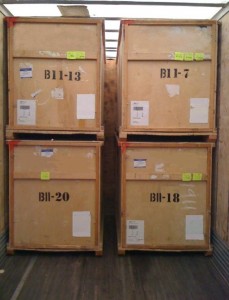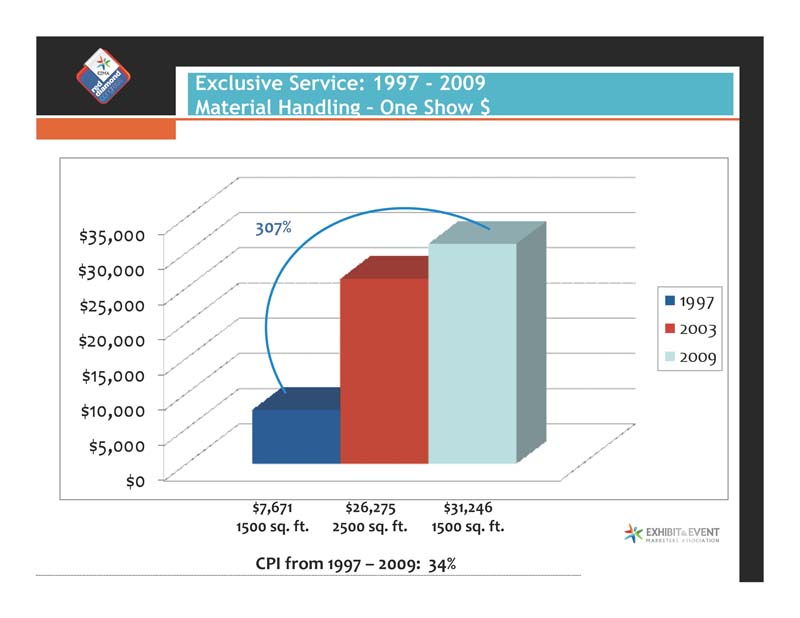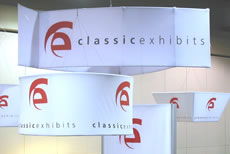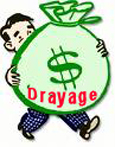Rising Drayage and Material Handling Costs
If you are a fan of the comedian Ron White, you know his signature line, “You Can’t Fix Stupid.” I was reminded of this line three weeks ago while attending a material handling session by Amanda Helgemoe from NuVista and Sue Huff from Medtronic at the Red Diamond Congress in Chicago. The presentation was based on a 2013 study endorsed by the Exhibit and Event Marketers Association (E2MA) Advocacy Committee.
In short, it’s disturbing.
The presentation consists of 50 informative slides, mostly case studies between 1996 and 2007, and an analysis of rising, comparative costs. I won’t summarize the full presentation because: a) the summary would be longer than the study, and b) You’re not stupid. You can read it and draw your own conclusions. That said . . . I strongly encourage you to devote 20-30 minutes to reviewing it. Secondly, you need to share your concerns, opinions, and solutions with industry associations and show management.
Finally, if you work directly with exhibitors regularly, you need to encourage them to speak to the associations sponsoring the trade shows. I believe, and I’m going to be a little naive here, that they don’t fully understand the ramifications of their no-cost contracts with the General Show Contractors or Show Management. Costs are rising, in particular drayage, at a rate that’s unsustainable to our industry. Whatever your political bent, the rich are getting richer, the poor are getting poorer, and the foundational middle is crumbling in the trade show industry. This tainted concentration of power is doing what power always does – corrupts.
Some Highlights:
- Exhibitors are downsizing or cancelling programs, not because face-to-face marketing is ineffective, but because rising costs are squeezing their exhibit budgets.
- Exhibitors DO NOT KNOW 30% of their final costs headed into a show. No other marketing medium has the same cost uncertainty/surprises.
- Don’t blame labor. I&D costs have increased, but those costs pale in comparison to exclusive services such as material handling.
- At one show material handling increased 307% between 1997 and 2009. And there were two recessions during this time.
- Show Organizers are not doing their homework. There is often a wide variance in costs between similar shows in the same city within 6 months.
- Here’s how crazy it’s gotten (example): Drayage: $116.70/cwt, One crate = 1100 lbs., Drayage cost = $1,283.70, Associated GSC labor cost = 37 hours ($35.00/hour), NOW HOLD YOUR BREATH – That equals 1 person, working 4 ½ days for one crate.
- From 2009-2013, the Consumer Price Index increased 8.2%. General Contractor Labor Costs increased 12.56%. Drayage increased 121%.
- Material Handling has (purposely) gotten more opaque. In some situations, there are 24 material handling categories. Opacity makes it much harder for exhibitors to challenge drayage charges or make fiscally sound decisions when scheduling freight. This is not an accident.
- General Service Contractors are shifting costs to exhibitors who do not use them for non-exclusive services, resulting in uneven application of exclusive service charges. All too often, exhibitors are paying the drayage for the exhibitor right next to them when the GSC shifts expenses.
- Growing use of bundling by GSCs by offering discounts/rebates to win the entire corporate program, such as waiving material handling if client rents from the GSC. The EDPA and E2MA have gone on record as stating this practice (bundling) is unethical and anti-competitive.
The study proposes solutions beginning on slide 44, which I strongly encourage you to review. Those include Best Practices on slide 49. On a personal note, I cannot emphasize enough how much your voice matters to trade show industry associations, such as E2MA and EDPA. Let them hear from you. In addition, if you are an exhibitor, please voice your concerns directly with the association sponsoring the show and show management. I believe that associations do not understand how existing contracts undermine their ability to grow the shows they sponsor. Show management, however, does understand the impact of rising material handling costs, but (many) have not felt enough financial pain to recommend changes.
Thank you for your time, and I hope you share my passion and concern for our industry. Collectively, I believe we can fix stupid. We have no other choice.
–Mel White
http://www.linkedin.com/in/melmwhite
mel@classicexhibits.com
**********************************************
Based in Portland, Oregon, Classic Exhibits Inc. designs and manufacturers portable, modular, and custom-hybrid exhibit solutions. Classic Exhibits products are represented by an extensive distributor network in North America and in select International markets. For more information, contact us at 866-652-2100 or www.classicexhibits.com.
[subscribe2]










